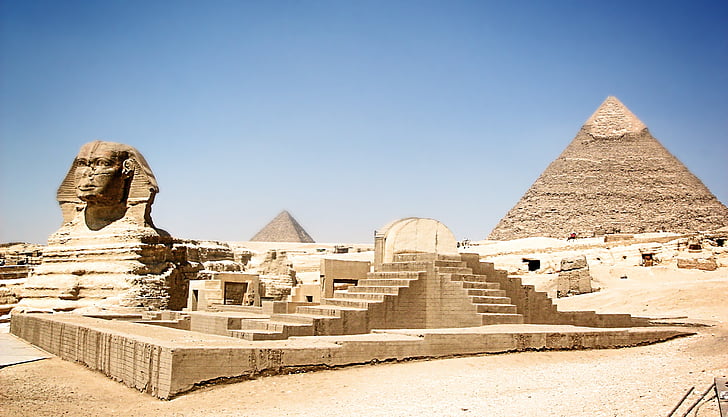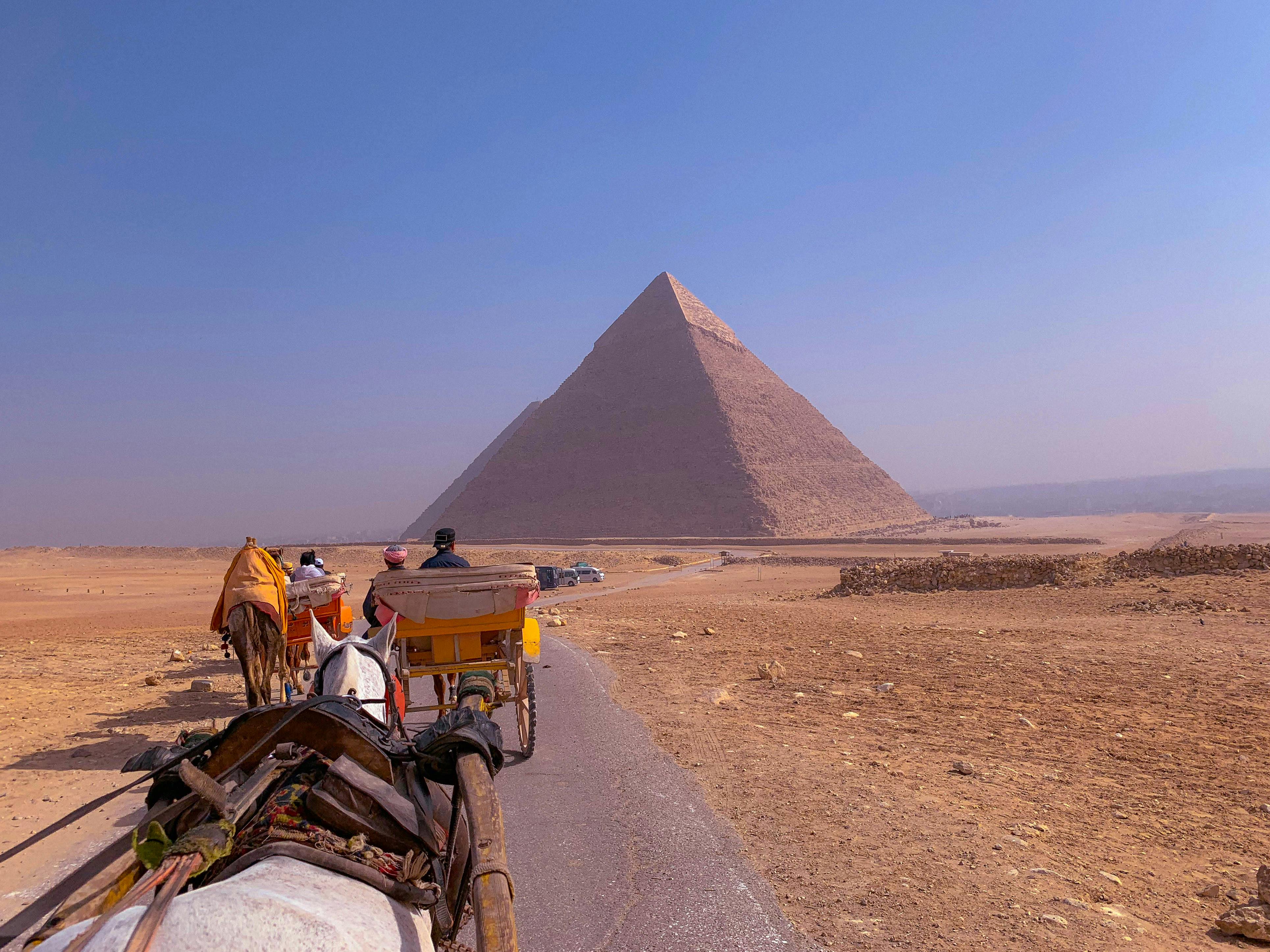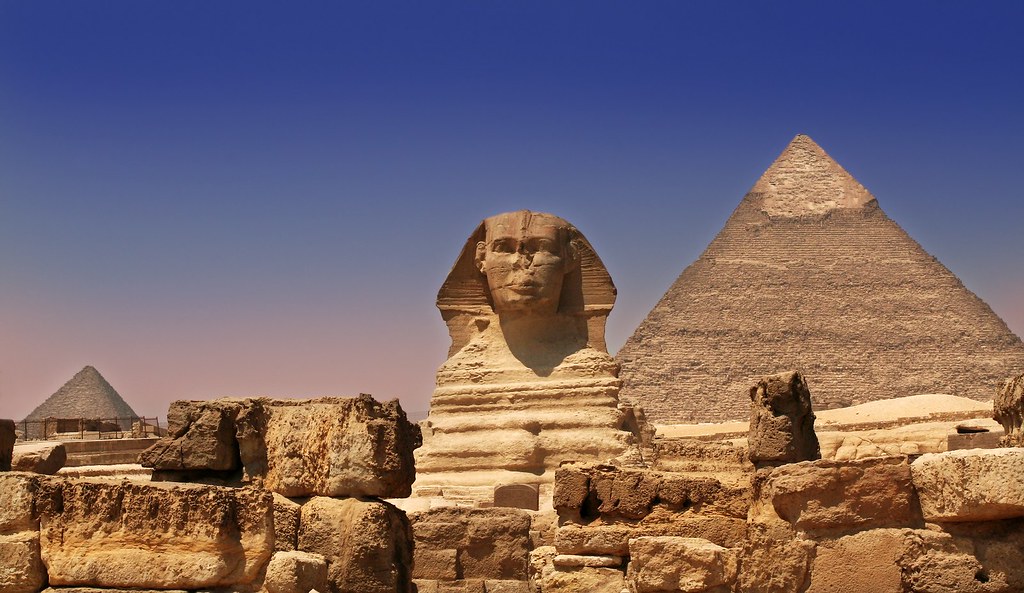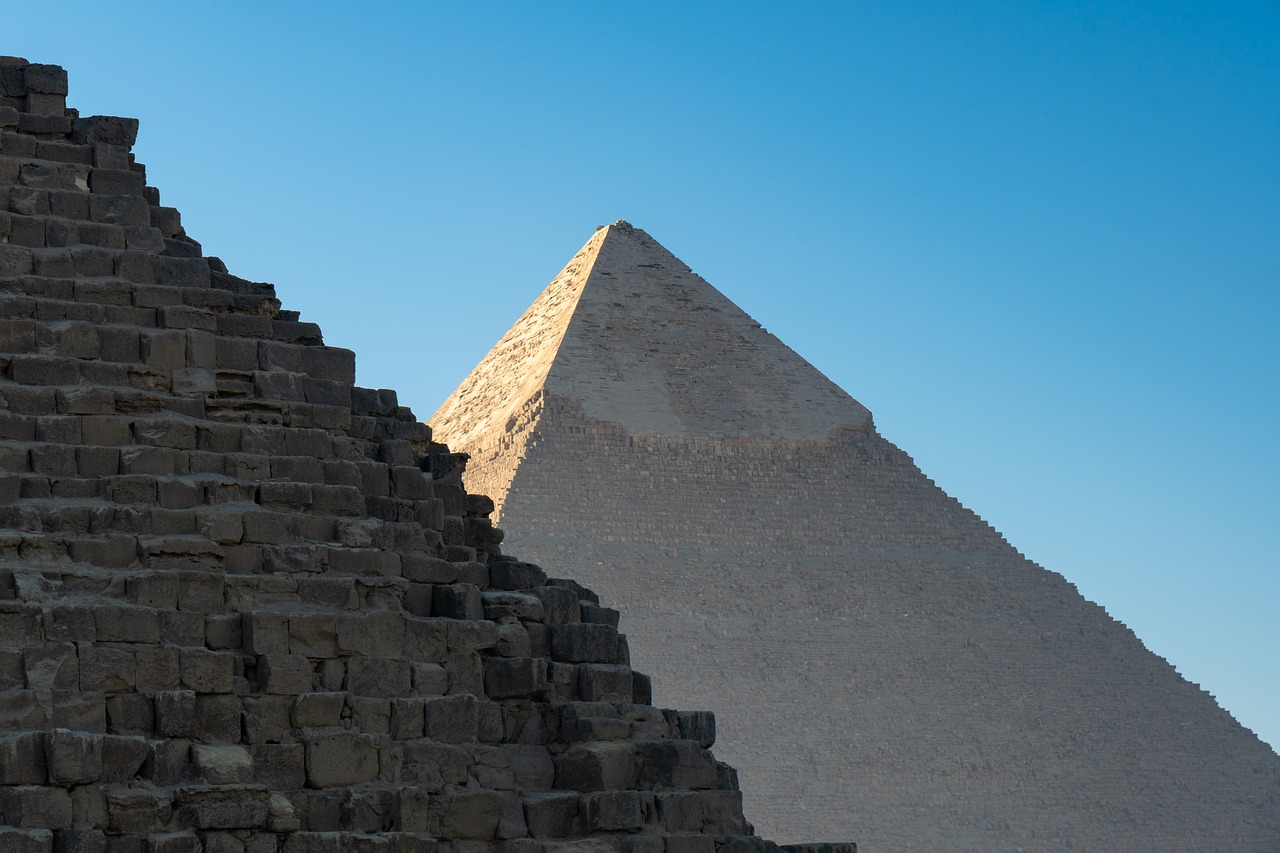The Pyramids of Giza stand as timeless sentinels of ancient Egypt's grandeur and ingenuity, captivating the imaginations of travelers from around the globe. With their towering stature and enigmatic allure, these monumental structures have beckoned adventurers, historians, and dreamers for centuries, drawing them to the sandy expanse of the Giza Plateau in search of answers and awe-inspiring experiences. Tourists flock to the Pyramids of Giza for a myriad of reasons, driven by a shared fascination with the mysteries of antiquity, the enduring legacy of pharaonic civilization, and the profound sense of wonder that arises in the presence of these iconic monuments. From unraveling the secrets of their construction to basking in their timeless majesty against the backdrop of the Egyptian desert, visitors are irresistibly drawn to the Pyramids of Giza for an unforgettable journey through the annals of history and the depths of human imagination.
Why Do People Visit The Great Pyramid Of Giza?
Tourists visit the Pyramids of Giza for several compelling reasons:
- Ancient Wonder: The Pyramids of Giza are among the most iconic and enduring symbols of ancient Egypt. Built over 4,500 years ago as tombs for the pharaohs, these colossal structures are marvels of engineering and architecture, captivating visitors with their sheer size and grandeur.
- Historical Significance: The Pyramids of Giza hold immense historical significance as part of Egypt's rich cultural heritage. They represent a remarkable feat of human ingenuity and craftsmanship, offering insights into the beliefs, rituals, and achievements of ancient Egyptian civilization.
- Mystery and Intrigue: The pyramids have long been shrouded in mystery and intrigue, sparking fascination and speculation about their construction methods, purpose, and symbolism. Visitors are drawn to unraveling the secrets of these enigmatic monuments, fueling their sense of wonder and curiosity.
- Bucket List Destination: For many travelers, visiting the Pyramids of Giza is a once-in-a-lifetime experience and a must-see destination on their bucket list. Standing in the presence of these ancient wonders and witnessing them up close is a profound and unforgettable moment for many.
- Cultural Immersion: Exploring the Pyramids of Giza offers tourists the opportunity to immerse themselves in Egypt's rich cultural tapestry. From admiring intricate hieroglyphs and ancient artifacts to learning about pharaonic history and mythology, visitors gain a deeper appreciation for Egypt's timeless heritage.
- Spectacular Views: Aside from the pyramids themselves, the Giza Plateau offers spectacular panoramic views of the surrounding desert landscape and the iconic Sphinx. Tourists can marvel at the breathtaking vistas and capture memorable photographs of these ancient wonders against the backdrop of the Egyptian sky.
- Spiritual and Mystical Significance: For some visitors, the Pyramids of Giza hold spiritual and mystical significance, representing a connection to ancient wisdom, spirituality, and the cosmos. Many travelers are drawn to the pyramids' powerful energy and aura, seeking spiritual insights and personal transformation.
Great Pyramids of Giza - History, Important Facts to Know
The Great Pyramids of Giza, located on the Giza Plateau near Cairo, Egypt, are among the most iconic and enduring symbols of ancient Egyptian civilization. Here are some important facts about these ancient wonders:
Age and Construction: The Great Pyramids were built over 4,500 years ago during the Fourth Dynasty of the Old Kingdom period of ancient Egypt. The largest and most famous pyramid, known as the Great Pyramid, was constructed for Pharaoh Khufu (also known as Cheops) and is believed to have been completed around 2560 BCE.
Monumental Size: The Great Pyramid of Khufu is the largest of the three pyramids at Giza and originally stood at a height of approximately 146.6 meters (481 feet). It held the record as the tallest man-made structure in the world for over 3,800 years until the construction of the Lincoln Cathedral in England in 1311 CE.
Architectural Features: The pyramids were built using millions of limestone blocks, some weighing up to 80 tons, and were constructed using sophisticated engineering techniques for the time. The precise methods of construction and the purpose of the pyramids continue to be topics of debate among scholars and researchers.
Alignment and Orientation: The Great Pyramid of Khufu is aligned with remarkable precision to the cardinal points of the compass (north, south, east, and west). Its sides are oriented almost perfectly to the four cardinal directions, indicating a sophisticated understanding of astronomy and mathematics by the ancient Egyptians.
Interior Chambers: The Great Pyramid contains several interior chambers, including the King's Chamber, the Queen's Chamber, and a network of passageways and corridors. The purpose of these chambers remains a subject of speculation, with theories ranging from burial chambers for the pharaohs to astronomical observatories.
Sphinx: Adjacent to the pyramids stands the Great Sphinx of Giza, a colossal limestone statue depicting a reclining lion with a human head. Believed to have been built during the reign of Pharaoh Khafre (Chephren), the Sphinx is one of the world's largest and oldest statues.
Historical Significance: The Great Pyramids of Giza hold immense historical and cultural significance as enduring symbols of ancient Egypt's power, wealth, and spiritual beliefs. They are UNESCO World Heritage Sites and are considered among the Seven Wonders of the Ancient World.
Tourist Attractions: Today, the Great Pyramids of Giza are major tourist attractions, drawing millions of visitors each year from around the world. Visitors can explore the pyramids' exteriors, enter some of the interior chambers, and marvel at the ingenuity and craftsmanship of ancient Egyptian civilization.
The Great Pyramids of Giza continue to fascinate and inspire people with their monumental size, architectural precision, and enduring legacy as testaments to the achievements of ancient Egypt.
Pyramids Of Giza - Entrance Fee and Opening Times
Here is some general information about the entrance fees and opening times for the Pyramids of Giza:
Entrance Fees: 80 - 200 EGP
- For foreign tourists: The entrance fee to the Giza Plateau, which includes access to the Pyramids of Giza and the Sphinx complex, is typically around 200 Egyptian pounds (EGP), which is roughly equivalent to $12 USD.
- For Egyptian residents: The entrance fee for Egyptian residents is usually lower, around 80 EGP.
Opening Times: Early Morning until Late Afternoon
- The Giza Plateau is generally open to visitors daily from early morning until late afternoon.
- Opening times may vary slightly depending on the season, so it's a good idea to check with official sources or tour operators for the most up-to-date information before planning your visit.
- It's advisable to arrive early in the morning to avoid the heat and crowds, especially during the peak tourist season.
The Pyramids Of Giza - Travel Plan & Itinerary
Here's a suggested travel plan and itinerary for visiting the Pyramids of Giza:
Day 1: Arrival in Cairo
- Arrive in Cairo, Egypt, either at Cairo International Airport or by other means of transportation.
- Check into your hotel in Cairo and rest after your journey.
- Spend the evening exploring the vibrant city of Cairo, perhaps enjoying a traditional Egyptian meal at a local restaurant.
Day 2: Visit the Pyramids of Giza
- Wake up early to beat the crowds and the heat.
- Head to the Pyramids of Giza, located on the Giza Plateau just outside Cairo.
- Explore the Great Pyramid of Khufu (Cheops), the Pyramid of Khafre (Chephren), and the Pyramid of Menkaure, as well as the nearby Sphinx complex.
- Take a camel ride around the pyramids for a unique perspective and photo opportunities.
- Visit the Solar Boat Museum to see the reconstructed solar boat of Khufu.
- Enjoy lunch at a nearby restaurant offering views of the pyramids.
- In the afternoon, consider visiting the nearby ancient city of Memphis and the Step Pyramid of Djoser at Saqqara.
- Return to Cairo in the evening and relax at your hotel.
Day 3: Explore Cairo
- Spend the day exploring the many attractions of Cairo, such as the Egyptian Museum, home to a vast collection of ancient artifacts, including treasures from Tutankhamun's tomb.
- Visit the Citadel of Saladin and the Alabaster Mosque for panoramic views of the city and a glimpse into Cairo's Islamic history.
- Explore the bustling Khan El Khalili Bazaar, where you can shop for souvenirs, spices, and traditional handicrafts.
- Enjoy dinner at a rooftop restaurant overlooking the Nile River.
- Alternatively, consider taking a dinner cruise on the Nile for a memorable dining experience.
Day 4: Departure
- Depending on your flight schedule, spend your last morning in Cairo visiting any remaining sights or doing some last-minute shopping.
- Check out of your hotel and transfer to Cairo International Airport for your departure flight.
This itinerary provides a balanced mix of exploring the ancient wonders of the Pyramids of Giza, experiencing the cultural richness of Cairo, and enjoying the vibrant atmosphere of Egypt's capital city. Adjustments can be made based on your interests, available time, and any specific attractions or activities you wish to prioritize during your visit.
The Pyramids Of Giza - Hotels & Resorts to Stay
- Mena House, Cairo: This iconic hotel is located just steps away from the Pyramids of Giza, offering luxurious accommodations with stunning views of the pyramids and lush gardens. Guests can enjoy world-class amenities, including multiple restaurants, swimming pools, and a spa.
- Le Meridien Pyramids Hotel & Spa: Situated within close proximity to the pyramids, this upscale hotel features spacious rooms with modern amenities, several dining options, a rooftop bar with panoramic views, and a full-service spa.
- Marriott Mena House, Cairo: Another luxurious option near the pyramids, this hotel offers elegant rooms and suites with Nile or pyramid views, multiple restaurants serving international cuisine, outdoor swimming pools, and a fitness center.
- Pyramids View Inn: For a more budget-friendly option, consider staying at this charming guesthouse with views of the pyramids from its rooftop terrace. The inn offers comfortable rooms, Egyptian-style hospitality, and easy access to the Giza Plateau.
- Giza Pyramids Inn: This family-run hotel is located within walking distance of the pyramids and offers affordable accommodations with modern amenities. Guests can enjoy a complimentary breakfast, free Wi-Fi, and assistance with arranging tours and transportation.
- Panorama Pyramids Inn: Offering budget-friendly accommodations with views of the pyramids, this inn provides comfortable rooms, a rooftop terrace, and a relaxed atmosphere. It's a great option for travelers seeking affordable lodging near the Giza Plateau.
- Guardian Guest House: Nestled in a quiet neighborhood near the pyramids, this guesthouse offers cozy rooms with Egyptian decor and friendly service. Guests can enjoy a complimentary breakfast, free Wi-Fi, and assistance with booking tours and excursions.
- Sphinx Guest House: Located just a short walk from the pyramids, this guesthouse offers basic yet comfortable accommodations with views of the Sphinx and easy access to the Giza Plateau. Guests can relax in the garden or on the rooftop terrace after a day of sightseeing.
How Much Does It Cost To Visit The Pyramids?
The cost of visiting the Pyramids of Giza can vary depending on several factors, including whether you are a local resident or a foreign tourist, the type of ticket you purchase, and any additional services or tours you may opt for. Here are some general guidelines:
- Entrance Fees: As of my last update, foreign tourists typically pay higher entrance fees compared to Egyptian residents. The cost for foreign tourists to enter the Giza Plateau, which includes access to the pyramids and the Sphinx complex, is around 200 Egyptian pounds (EGP), which is roughly equivalent to $12 USD. For Egyptian residents, the entrance fee is significantly lower, usually around 80 EGP.
- Additional Services: In addition to the basic entrance fee, visitors may choose to purchase tickets for specific attractions or services within the Giza Plateau. For example, there may be separate fees for entering the interior chambers of the Great Pyramid or for taking a camel ride around the site. The cost of these additional services can vary.
- Guided Tours: Many visitors opt to take guided tours of the Pyramids of Giza, which can provide valuable insights into the history, architecture, and significance of these ancient monuments. The cost of guided tours can vary depending on the duration, level of expertise of the guide, and any additional services included.
- Transportation: If you are traveling to the Pyramids of Giza from Cairo or another nearby city, you may incur additional costs for transportation. This can include taxi fares, public transportation tickets, or the cost of hiring a private driver or tour operator.
When Is The Best Time Of Year To Visit The Pyramids?
The best time of year to visit the Pyramids of Giza is typically during the cooler months of late autumn, winter, and early spring, specifically from November to February. During this time, the weather in Cairo and the surrounding area is milder and more comfortable for outdoor exploration, with temperatures ranging from around 15°C to 25°C (59°F to 77°F) on average.
Visiting during the cooler months allows you to explore the Giza Plateau and the Pyramids of Giza without having to contend with extreme heat, which can be intense during the summer months. High temperatures during the summer, which can soar well above 30°C (86°F) and sometimes even reach 40°C (104°F) or higher, can make outdoor activities uncomfortable and exhausting, especially for extended periods of time.
In addition to the more comfortable weather, visiting during the cooler months also means fewer crowds and shorter lines at popular attractions, allowing you to enjoy a more relaxed and immersive experience. The off-peak season from November to February tends to be less busy compared to the peak tourist season during the summer months, making it an ideal time to visit if you prefer a quieter and more tranquil atmosphere.
However, it's important to keep in mind that weather patterns can vary from year to year, so it's a good idea to check weather forecasts and plan accordingly. Regardless of the time of year you choose to visit, be sure to bring plenty of sunscreen, a hat, sunglasses, and plenty of water to stay hydrated, as the desert climate can be dry and sunny year-round.
When Did The Pyramids Of Giza Become A Tourist Attraction?
The Pyramids of Giza have been attracting visitors for centuries, even millennia, but their status as a modern tourist attraction can be traced back to the 19th century.
During the 19th century, Egypt experienced a surge in interest and exploration by European travelers, archaeologists, and adventurers. This period, known as the "Golden Age of Egyptian Archaeology," saw the rediscovery and excavation of many ancient Egyptian sites, including the Pyramids of Giza.
The advent of steamships and railways made travel to Egypt more accessible to tourists from Europe and other parts of the world. As a result, the Pyramids of Giza quickly became a popular destination for travelers seeking adventure, cultural enlightenment, and the chance to witness firsthand the wonders of ancient Egypt.
In the late 19th and early 20th centuries, the Pyramids of Giza became synonymous with exoticism and mystery, attracting tourists, scholars, and explorers from around the globe. The opening of the Egyptian Museum in Cairo in 1902 further enhanced Egypt's appeal as a destination for cultural tourism, as it housed many of the artifacts and treasures unearthed from ancient Egyptian tombs and temples, including those from the Pyramids of Giza.
Since then, the Pyramids of Giza have remained one of the world's most iconic and enduring tourist attractions, drawing millions of visitors each year to marvel at their ancient splendor and ponder the mysteries of Egypt's distant past.
Can I Climb To The Top Of The Pyramids In Giza?
No, it is not permitted to climb to the top of the pyramids at Giza. Climbing the pyramids is strictly prohibited to preserve these ancient structures and ensure the safety of visitors. The pyramids are delicate archaeological sites, and climbing them can cause damage to the limestone blocks and undermine their structural integrity.
Additionally, climbing the pyramids is considered disrespectful to the cultural heritage of Egypt and is subject to strict enforcement by authorities. Visitors are encouraged to admire the pyramids from ground level and explore the surrounding areas, including the Sphinx and nearby archaeological sites, while adhering to the rules and regulations set forth by Egyptian authorities and UNESCO.
While climbing to the top of the pyramids is not allowed, visitors can still experience the majesty and grandeur of these ancient wonders up close by taking guided tours, entering some of the interior chambers, and learning about their history and significance from knowledgeable guides and interpreters.
How Many Tourists Visit The Pyramids Of Giza?
In 2019, for example, Egypt reported a record-breaking number of tourists, with over 13 million visitors arriving in the country. While specific data on the number of tourists visiting the Pyramids of Giza may not be readily available, it is safe to assume that they attracted a significant portion of these visitors, given their iconic status and historical significance.
However, during the COVID-19 pandemic, travel restrictions and safety concerns led to a sharp decline in tourism worldwide, including in Egypt. As a result, the number of tourists visiting the Pyramids of Giza likely decreased significantly during this period.
As travel restrictions ease and tourism begins to recover, it is expected that the Pyramids of Giza will continue to attract millions of visitors each year, eager to experience the awe-inspiring wonders of ancient Egypt.
Can Tourists Go Inside The Pyramids Of Giza?
Yes, tourists can go inside some of the pyramids at Giza, including the Great Pyramid of Khufu (also known as the Pyramid of Cheops) and the Pyramid of Khafre (also known as the Pyramid of Chephren). However, access to the interior chambers of the pyramids is limited and requires purchasing an additional ticket on-site. It's important to note that only a certain number of visitors are allowed inside each day, and there may be restrictions or closures for maintenance or preservation purposes. Additionally, the interior passages can be narrow, steep, and dimly lit, making them unsuitable for those with claustrophobia or mobility issues. Nonetheless, for those who are able to enter, exploring the interior of these ancient wonders offers a unique and unforgettable glimpse into the mysteries of ancient Egypt's funerary practices and architectural marvels.












No comments:
Post a Comment